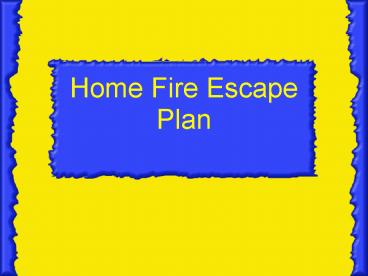Home Fire Escape Plan PowerPoint PPT Presentation
1 / 9
Title: Home Fire Escape Plan
1
Home Fire Escape Plan
2
Home fires can grow and spread very quickly. In a
typical fire, you may have as little as two
minutes to escape once the smoke alarm sounds.
Knowing how to use those minutes wisely can make
a life-saving difference. Developing and
practicing a home fire escape plan will help you
snap into action immediately if the smoke alarm
sounds, so you can get out quickly and safety.
The following suggestions are provided to help
you develop a thorough home fire escape plan.
3
Make sure you have at least one smoke alarm on
each level of your home and in or near each
sleeping area. Test the alarms every month by
pushing the test button, and replace the
batteries once a year or when the alarm chirps,
warning that the battery is low. Newer smoke
alarms have a signal repetition pattern of three
beeps, followed by a one and a half second pause.
Make sure the street number/address of your home
is visible to firefighters.
4
Draw a floor plan of your home. Mark all doors
and windows, and the location of each smoke
alarm. If windows or doors have security bars,
equip them with quick-release devices. Locate two
escape routes from each room. The first way out
would be the door, and the second way out could
be a window. In case of fire, close all doors
behind you as you exit your home to slow the
spread of fire and smoke. If your exit is blocked
by smoke or fire, use your second exit to escape.
If you must escape through smoke, stay low and
crawl under the smoke to safety. Smoke will rise
to the ceiling, leaving cooler, cleaner air close
to the floor. Crawl on your hands and knees, not
belly, because heavier poisons will settle in a
thin layer on the floor.
5
(No Transcript)
6
If you live in a high-rise building, plan to use
the stairs never the elevator. Count the
number of doors between your apartment and the
two nearest exits. If you discover fire, sound
the fire alarm and call the fire department.
Leave the area quickly, taking your key and
closing all doors behind you. If the building has
a voice enunciation system, follow its
instructions precisely, unless doing so puts you
in immediate danger. If fire or smoke blocks
your exits, stay in your apartment and cover all
cracks and vents (using wet towels, duct tape,
linens, clothing, and so forth) to prevent smoke
from entering. Telephone the fire department,
even if firefighters are already at the building,
and tell them where you are. Signal to
firefighters for help with a light cloth. If
possible, open the window at the top and bottom,
but be ready to shut the window immediately.
7
Choose a meeting place a safe distance from your
home and mark it on the escape plan. A good
meeting place would be a tree, telephone pole, or
a neighbor's home. In case of fire, everyone
should gather at this designated meeting place.
8
Memorize the emergency number of the local fire
department. Once outside, call that number
immediately from a nearby or neighbor's phone, or
use a portable or cellular phone you can grab
quickly on the way out.
9
Practice your escape drill at least twice a year,
and remember -- NEVER go back inside a
burning building!

